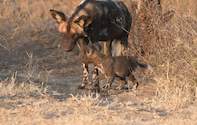
New research on the wild dog population in the Kruger National Park has revealed that the amount of rain that falls before wild dogs give birth to pups is an important factor in determining whether the pups will live or die. Using data gathered in southern Kruger and the Sabie Sand Wildtuin from 1989 to 2004, a team of researchers including Ursula Buettner, Harriet Davies-Mostert, Johan du Toit and Gus Mills, has revealed that dry spells before the birth of pups helps them to survive up to the age of nine months, after which other things start to influence their survival.
The Kruger National Park contains the largest single population of wild dogs in South Africa, and the only one that is considered to be viable without human interference. Conservation of the wild dog is a priority in protected areas, as it is the most endangered carnivore in southern Africa and one of the most endangered carnivores on earth.
Previous studies of wild dogs have shown that young dogs are important drivers of whether populations rise or fall, and so gaining an insight into what helps pups survive is one way of ensuring that conservation efforts are more successful.
Kruger was an ideal place to study this, due to the long period over which wild dog information has been collected and because the dogs are so well known to the researchers. The abundance of weather stations in Kruger is also a bonus.
By analysing rainfall data and information about wild dog packs and their pups, they found that the amount of rain that fell up to two years before the pups were born could influence their survival. The amount of rain that fell in the six months after the pups were born had no effect on their survival.
Most wild dog pups are born in early June, and the researchers speculate that the condition of the pups' parents before they are born is partly responsible for their survival. If the weather has been dry beforehand, it is likely that the dogs find it easier to hunt for several reasons - the lower grass and smaller shrubs makes it easier to chase and catch prey, they can see obstacles that would be hidden in the grass better, and with less greenery to eat impala and other prey animals will be in poorer condition and easier to catch.
Also, the dogs are a bit safer when the grass is lower as lions, which are major killers of wild dogs, find it harder to stalk them. With less lion harassment and easier meals, the dogs will be in better condition and give birth to healthier pups in drier years.
The effect of preceding rainfall was most important for pup survival in the first six months, important to a lesser extent until the pups were nine months old, and was no longer linked to pup survival when the pups reached a year old. The researchers also looked at whether the number of adult dogs in a wild dog pack affected whether or not pups survived.
They found that up until six months, the rain that fell before the pups were born had more of an effect on pup survival. As the pups grew older, the effect of the rain diminished, and the number of adults in the pack played a more important role, with bigger packs increasing the chance of the pups becoming yearlings. One of the reasons for this might be linked to the way the dogs catch their prey. Because they work as a team, whether they catch a meal or not can depend on how many dogs are around to run for their lunch.
When pups are born, the wild dogs often leave an adult 'pup-guard' behind to look after the babies while they hunt. If leaving an adult behind means that it is that much harder to catch a meal, the dogs might leave the pups alone while they hunt. This leaves the pups vulnerable to other predators, like lions. Also, as the pups grow older and accompany adults on hunts, in a larger pack they are more likely to be protected while eating on a kill.
Armed with this new information about how rainfall and pack size affects the survival of wild dog pups, conservationists can better plan when and where to release new packs of dogs into other protected areas. However, when studying the wild dog data, it became apparent that there are also other factors that influence whether or not pups survive to adulthood, and more research is planned to uncover these things.
By Melissa Wray

 Wild Dogs (Lycaon Pictus) occur in low population numbers as a consequence of large territories. The Wild Dog is one of Africa's most endan...
Wild Dogs (Lycaon Pictus) occur in low population numbers as a consequence of large territories. The Wild Dog is one of Africa's most endan...